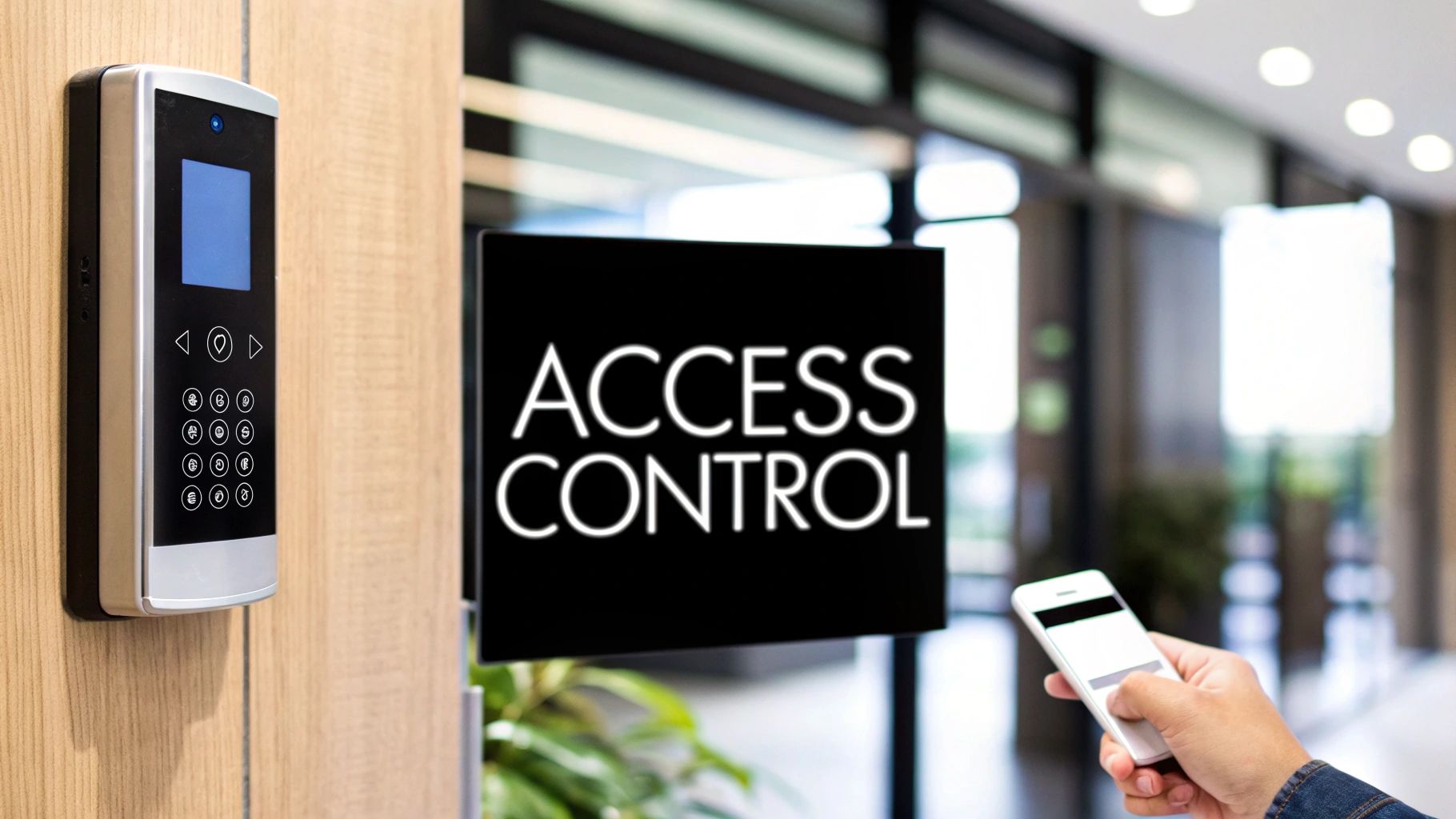Apartment access control systems are all about managing who gets in—and who doesn't—without fumbling for old-school metal keys. They’re the modern answer to building security, offering a huge upgrade in security, convenience, and day-to-day efficiency for everyone, from property managers to residents.
Moving Beyond Traditional Locks and Keys
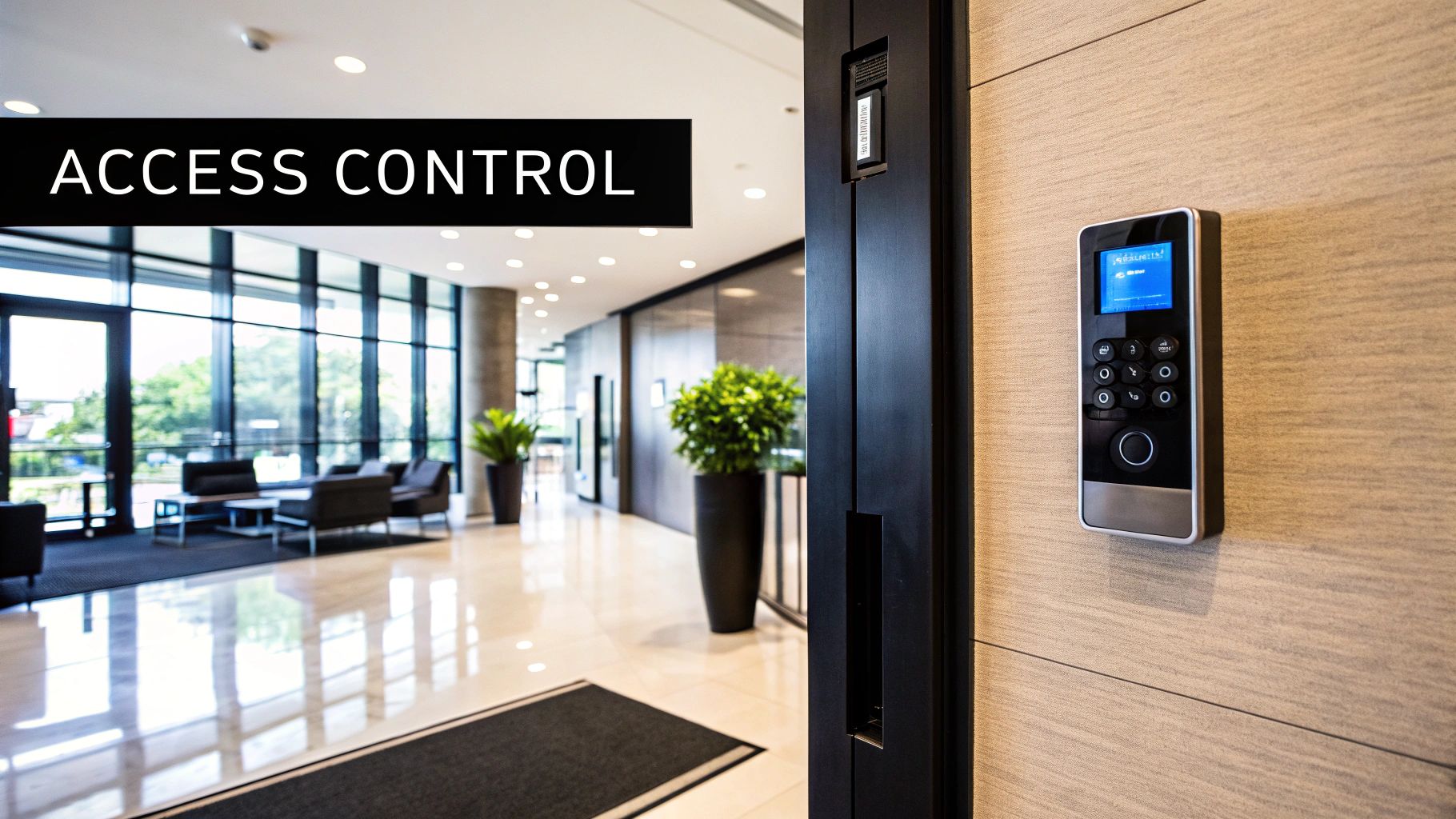
Think about it: relying on a traditional lock and key is like using a single, easily copied password for your entire building. When a key is lost or a tenant moves out, your only real option is to rekey the lock. That’s a hassle, it costs money, and it takes time. This old way of doing things is just too rigid and leaves some serious security gaps.
Modern apartment access control systems are the intelligent, digital gatekeepers that fix this. They swap out that static lock-and-key for a flexible system that puts you in charge of every single entry point—from the main lobby and parking garage to the gym and the front door of each unit. This approach creates a genuinely safer community for residents and a much smoother operation for managers.
Traditional Locks vs Modern Access Control at a Glance
The jump from metal keys to smart access is a big one. This table breaks down the core differences.
| Feature | Traditional Locks | Modern Access Control |
|---|---|---|
| Credential | Physical metal key | Digital (smartphone, key card, fob, biometric) |
| Access Control | All or nothing—key either works or it doesn't | Granular—set access by user, door, and time |
| Security Risk | High risk from lost/stolen keys; requires rekeying | Low risk—credentials can be revoked instantly from a central dashboard |
| Management | Manual, time-consuming key tracking and handoffs | Centralized, remote management of all access points and users |
| Audit Trail | None—no record of who entered or when | Detailed logs of every entry attempt (successful or failed) |
| Convenience | Requires physical key handoffs for guests, staff, tenants | Keyless entry; remote access granting for visitors and maintenance |
It's clear that modern systems aren't just a minor upgrade; they completely redefine what it means to manage property access.
The Shift to Smarter Security
This isn't just a small trend—it's a massive market shift. The global access control systems market is expected to rocket from USD 11.06 billion to roughly USD 25.15 billion between 2024 and 2034. That explosive growth shows just how much value property owners see in these systems.
This technology completely changes the game for property managers. For example, forget juggling keys for apartment showings. Managers are now implementing self-showings with smart lockboxes, which is a perfect real-world example of these modern solutions at work.
An access control system gives you precise control. You decide who gets access, which doors they can open, and at what specific times. It's the difference between a simple barrier and an intelligent security network.
This control goes all the way down to individual apartment doors. Smart locks are a huge piece of the puzzle, giving residents keyless entry and managers remote oversight. Our guide on https://clouddle.com/blog/smart-locks-for-apartments/ gets into the nitty-gritty of these devices.
At the end of the day, making the switch is a no-brainer for any modern residential building that wants to improve security, keep residents happy, and make life easier for the management team.
Decoding Different Types of Access Control
Diving into the world of apartment access control can feel a bit overwhelming at first. There are a lot of terms and technologies floating around. But really, it’s just about choosing the right tool for the job.
Think of it this way: you wouldn't use the same lock for your front door as you would for a garden shed. Similarly, the best access system for a main lobby is different from what you'd want for the pool gate. Let’s walk through the most common types you’ll find in modern apartment buildings, breaking down what they do best.
The Reliable Classics: Key Cards and Fobs
Key cards and fobs are the undisputed workhorses of access control, and for good reason. They’re simple, effective, and familiar to almost everyone. Using Radio-Frequency Identification (RFID) technology, a resident just has to tap their card or fob on a reader, and the door unlocks.
This is a massive leap forward from old-school metal keys. If a resident loses their fob, you can instantly deactivate it from the management software. No more expensive locksmith calls or re-keying entire floors. They hit a sweet spot between affordability and solid security, making them perfect for main entrances, garages, and amenity spaces.
The Ultimate Convenience: Mobile Access
This is where things get really slick. Mobile access control turns a resident's smartphone into their key. Using Bluetooth or NFC (Near Field Communication), a resident can unlock a door by tapping their phone on a reader or, in some cases, just by walking up to it.
For residents, this is peak convenience—one less thing to carry around. For property managers, the benefits are huge. You can grant or revoke access remotely, in real-time, from anywhere. Need to let a new resident in? Send them a digital key. Have a contractor coming for a one-time job? Grant them access for a specific window of time. It completely changes the game for managing access.
The image below gives you a good visual breakdown of how these different methods stack up against each other in terms of cost, convenience, and security.
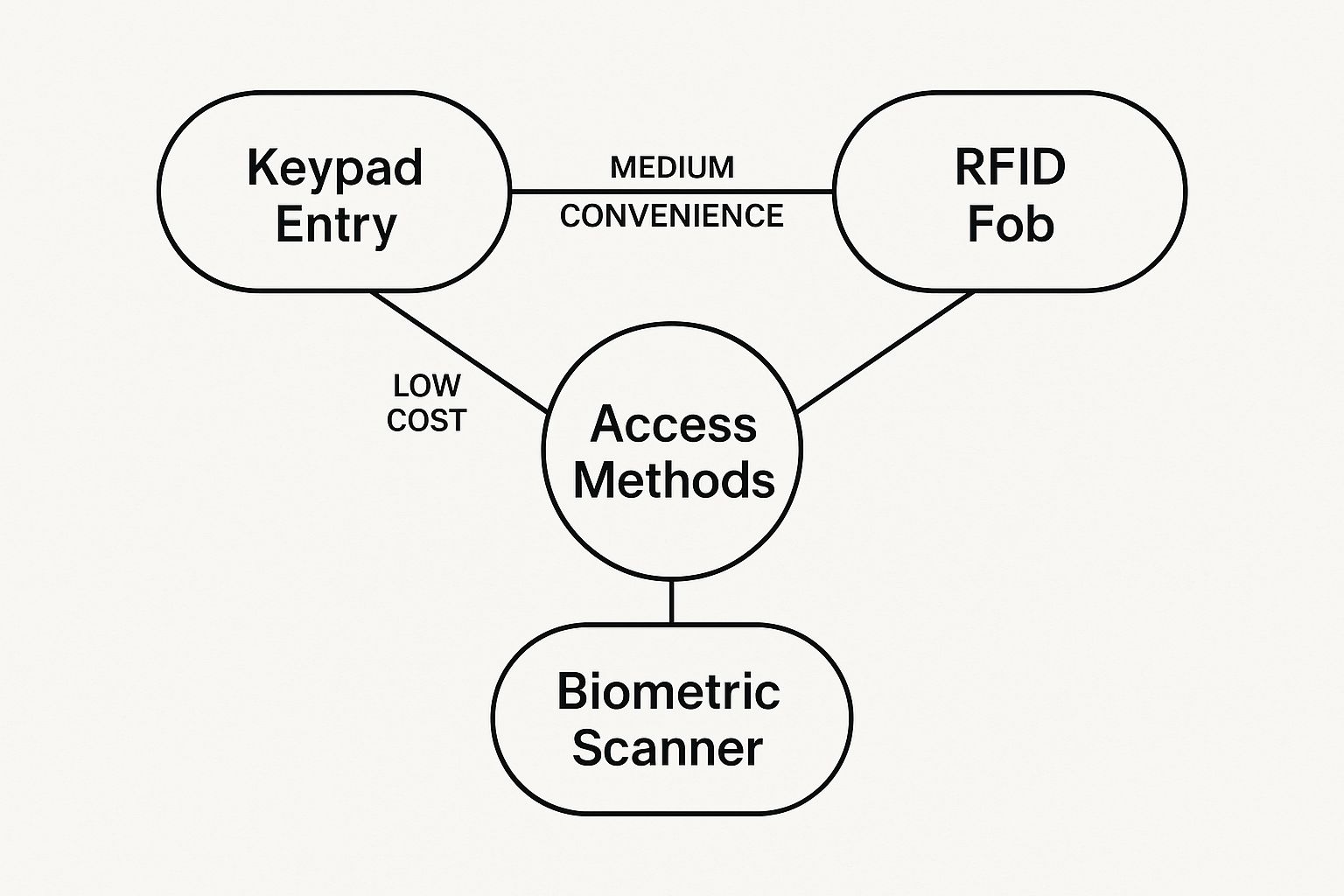
As you can see, there's always a trade-off. A simple keypad is easy on the budget but offers basic security, while something like biometrics provides iron-clad protection at a much higher price point.
The Simplicity of Keypads
Keypads are the most straightforward option out there. Residents just punch in a PIN code to get in. They're a really cost-effective way to secure common areas that don't need Fort Knox-level security, like laundry rooms or fitness centers.
The biggest selling point for keypads is their simplicity. There are no physical keys or fobs to hand out, manage, or lose. The flip side, of course, is that codes can be shared, forgotten, or even spotted by someone looking over a shoulder.
Modern keypads have come a long way, though. Most systems now let you assign unique codes to each resident and easily delete them when they move out, which adds a much-needed layer of control.
The Highest Security: Biometrics
When security is the absolute top priority, you look to biometrics. These systems verify a person's identity using their unique biological traits. In the apartment world, that usually means fingerprint scanners or facial recognition.
Because these traits can't be copied, lost, or stolen, biometrics offer the highest level of security you can get. While the upfront cost is higher, they are fantastic for protecting high-value areas like a package room, management office, or data closet. For luxury properties, offering biometric entry can be a serious differentiator that shows a commitment to cutting-edge security and a premium living experience.
What to Look For: Essential Features of a Modern System
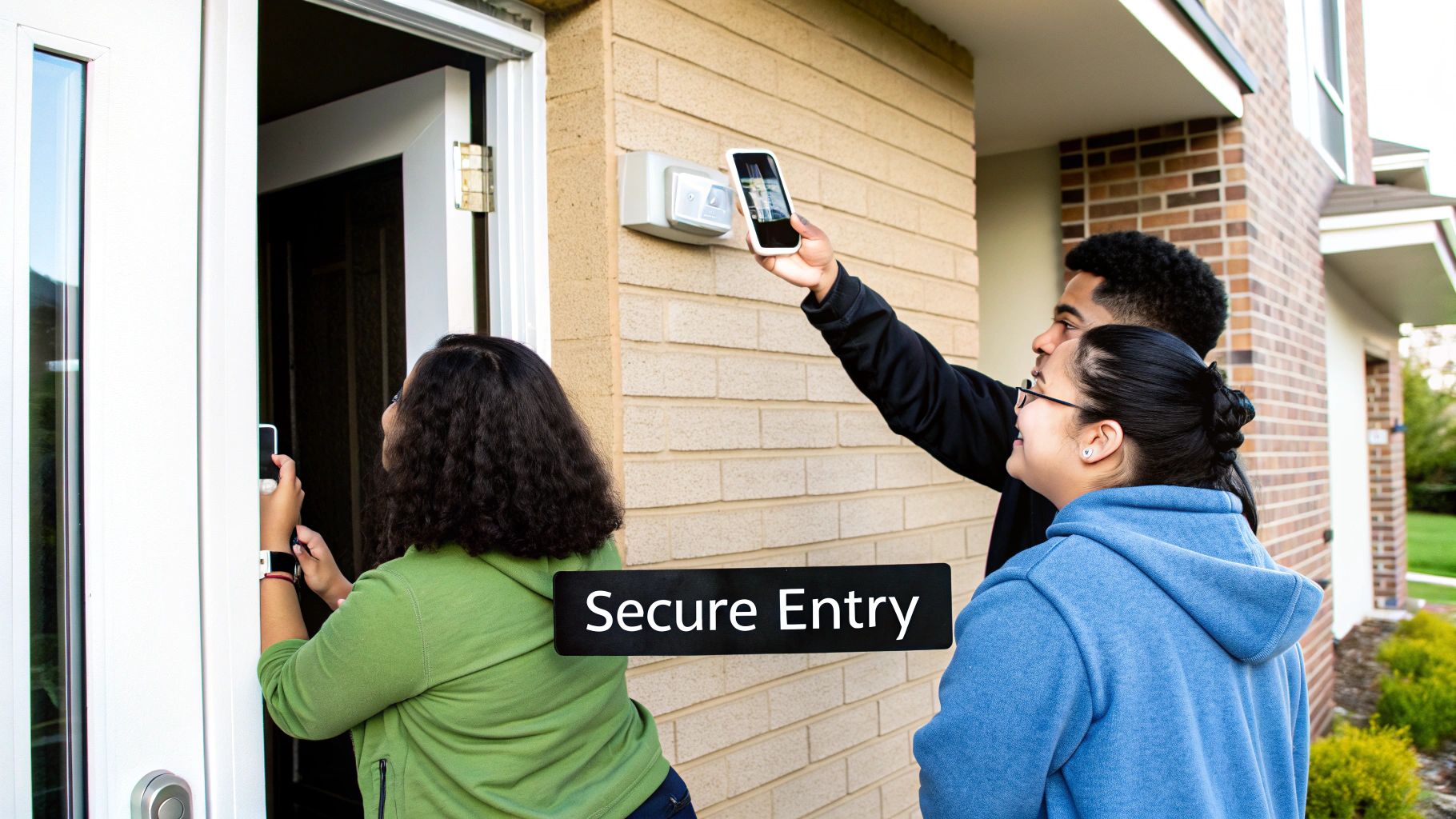
Picking a method for getting in the door—whether it's a key fob, a card, or a smartphone app—is really just the starting point. The true value in today’s apartment access control systems comes from the features that elevate them from simple electronic locks into powerful management tools. These are the capabilities that make a real difference, both for your operations and for your residents' daily lives.
Think of it like buying a new car. Any car will get you from A to B, but it’s the features like GPS, cruise control, and blind-spot monitoring that truly define the driving experience. It's the same with access control; the right features deliver a massive upgrade, making your building smarter, safer, and much simpler to manage.
Cloud-Based Management
One of the biggest game-changers is cloud-based management. This completely untethers you from a dedicated computer in a back office. Instead, your control panel becomes a secure dashboard you can access from any device with an internet connection—your laptop at home, your tablet on the road, or your phone.
Imagine a new tenant needs access right now, but you're miles away. With a cloud system, you can grant them a digital key in seconds, directly from your phone. No more rushing back to the property.
This remote power means you can instantly revoke a lost fob, tweak the pool's access hours, or review entry logs from anywhere. It's about having complete, real-time control without being physically chained to the building.
The industry is moving decisively in this direction. In fact, the global access control market is expected to grow to USD 61.31 billion by 2035, a massive jump fueled largely by cloud platforms and mobile credentials.
Seamless Integration Capabilities
A modern access control system shouldn't be an island. Its real power is unlocked when it can connect and communicate with the other technology in your building. When your systems can talk to each other, you automate tedious tasks and get a single, unified view of your property’s operations.
Here are a few key integrations to look for:
- Property Management Software (PMS): When you add a new resident to your PMS, the access system can automatically generate their credentials. When they move out, their access is cut off just as easily.
- Video Surveillance: By linking cameras to your access system, you can get a video clip of every time a door is used. It adds a powerful layer of visual proof to your entry logs.
- Intercoms and Visitor Systems: When a guest rings the intercom, you can see who they are and buzz them in, all from the same platform. It creates a smooth, professional experience for visitors.
This kind of connectivity is at the heart of how https://clouddle.com/blog/iot-in-property-management/ is transforming buildings into responsive, intelligent environments. To get a better sense of where things are headed, it's worth looking into the emerging property management technology trends that are shaping the industry.
Visitor and Delivery Management
Dealing with guests and the endless stream of packages is a daily operational headache. A good system tackles this challenge with features built specifically for temporary access. You or your residents should be able to issue temporary digital keys or one-time-use PIN codes for visitors, dog walkers, or maintenance staff.
For deliveries, the best systems can integrate directly with carriers to grant drivers one-time access to a secure package room. This simple feature drastically cuts down on stolen packages and clears up lobby clutter.
This isn't just a convenience; it's a major security upgrade and a valuable amenity that today's renters have come to expect. It finally puts an end to insecure workarounds like propping doors open or leaving keys under the mat.
Comprehensive Audit Trails and Reporting
At the end of the day, security is about knowing who went where and when. Every solid access control system maintains a detailed audit trail—a digital log of every single time someone tries to open a door. This log shows the user, the location, and the exact time for every entry, both successful and failed.
These reports are gold. You can use them to investigate an incident, track staff movements, or simply ensure accountability. You get a complete, searchable history of all activity, giving you both peace of mind and the hard data needed to make smart security decisions. It’s a level of visibility that a box of metal keys could never provide.
Benefits for Property Managers and Residents
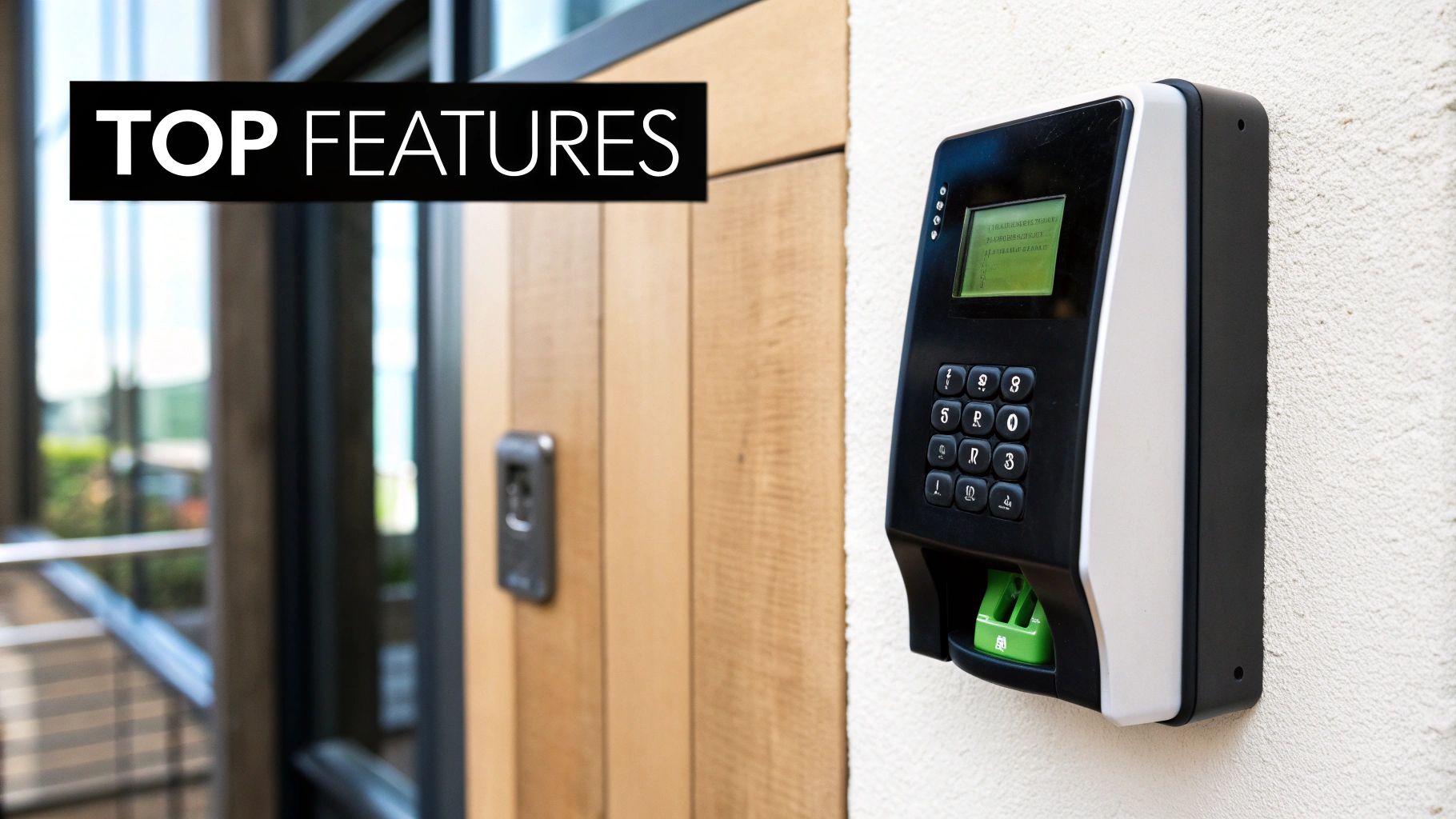
When you install a modern access control system, it’s not just about opening doors. It’s about fundamentally improving how your building operates for everyone—the people managing it and the people living in it.
This isn't a zero-sum game. The very features that make life easier for property managers are the same ones that create a safer, more convenient experience for residents. It’s a classic win-win that boosts property value and resident happiness at the same time.
How Access Control Benefits Everyone
A well-designed system addresses the core needs of both property management and residents, creating a more secure and efficient community. Here’s a quick breakdown of how these advantages play out for each group.
| Benefit Category | For Property Managers | For Residents |
|---|---|---|
| Security | Centralized control over all entry points with detailed audit trails to track every event. | A strong sense of safety knowing access is monitored and restricted to authorized individuals. |
| Efficiency & Cost | Eliminates the time and expense of rekeying locks during tenant turnover. | No more lost keys or expensive locksmith call-outs. |
| Convenience | Remotely manage access for staff, vendors, and new tenants from a single dashboard. | Keyless entry via smartphone or fob means no more fumbling for keys. |
| Control | Grant or revoke access instantly for any user at any door, 24/7. | Easily provide temporary access to guests, cleaners, or dog walkers through a simple app. |
Ultimately, a modern access control system creates a positive feedback loop: better management leads to happier residents, who are more likely to stay long-term.
For Property Managers: Smarter Operations and Ironclad Security
If you're a property manager, the right access control system can feel like a superpower. It automates some of the most frustrating parts of the job while giving you a clear, comprehensive view of building security. The days of tracking down stray keys or calling a locksmith for every move-out are officially over.
When a resident leaves, you can revoke their access credentials with a single click. Think about that—no more rekeying. That one feature saves a significant amount of time and money with every single turnover. Plus, the system keeps a detailed log of every entry attempt, which is gold when you need to investigate an incident or resolve a dispute.
This level of security is also a huge selling point. A building with a modern apartment access control system is instantly more appealing to prospective tenants, allowing you to attract higher-quality residents and often command better rent.
- Eliminate Rekeying Costs: Instantly deactivate old credentials, saving thousands of dollars a year on locksmith fees.
- Strengthen Security: Keep a close eye on all entry points with detailed event logs, which helps deter package theft and unauthorized entry.
- Boost Property Value: A secure, tech-forward building is a premium asset that helps attract and keep great residents.
- Simplify Management: Control every door—from the main entrance to the gym and pool—all from one straightforward platform.
For Residents: Seamless Convenience and Total Peace of Mind
For residents, the benefits are woven into their daily lives. Moving to keyless entry—whether it's with a smartphone app, a key fob, or a simple code—removes the small but constant hassle of digging for metal keys. It just makes life smoother.
Imagine being able to grant temporary access to your dog walker or a friend watering your plants while you're on vacation, all from your phone. You don't have to make copies of keys or worry about who has them. This gives residents an incredible amount of control and freedom.
But the biggest win for residents is the feeling of safety. Knowing your building is secured by a modern, monitored system provides a level of comfort that a simple deadbolt can never match.
This deep sense of security, combined with all the daily conveniences, completely transforms the living experience. It makes an apartment feel more like a safe, modern home, which leads to happier, long-term residents and a stronger community.
How to Choose the Right Access Control System
Picking the right access control system for your apartment building is a big decision, but it doesn't need to be a headache. If you break it down into a few common-sense steps, you can find a solution that fits your building, your budget, and your goals for the future.
First things first, you need to know what you’re working with. Walk the property and make a list of every single spot that needs to be secured. Think about the obvious ones like the main lobby and resident doors, but don't forget the parking garage, elevators, the gym, the pool, and even the package room. It's also a good time to check your existing infrastructure—do you have wiring ready to go, or is a wireless system going to be a better fit?
Assess Scalability and Future Needs
Your building isn't set in stone, and neither should your security system be. What does the future look like? Are you planning to build a new wing, add more units, or open a new amenity space? A scalable system is designed to grow with you, letting you add new doors or features without having to rip everything out and start from scratch.
Think of it this way: a scalable system protects your initial investment. It ensures your security tech keeps up with your property's needs for years to come instead of becoming obsolete in a few.
This kind of forward-thinking is becoming more important every day. The global market is shifting, and by 2035, the Asia Pacific region is projected to make up 48.9% of the access control market, thanks to booming cities and new smart infrastructure. This just goes to show how crucial it is for residential buildings everywhere to plan for growth.
Evaluate Costs and Vendor Reputation
You have to look at the total cost of ownership, not just the sticker price. It's easy to get caught up in the initial quote, but the real cost includes a few different pieces.
- Upfront Hardware: This is the physical stuff—the readers, control panels, and electronic locks for every door.
- Installation Fees: Don't forget to factor in the cost for a professional to get it all wired up and running correctly.
- Ongoing Software Subscriptions: Most modern cloud-based systems come with a monthly or annual fee. This usually covers software updates, cloud access, and customer support.
Finally, do your homework on the vendors. The company you choose to partner with is just as important as the technology they sell. Look for providers who have a solid history of working with multi-family properties. Check out their reviews, ask to see case studies from buildings like yours, and find out what their support looks like. A great partner will provide training, be there when you need them, and offer a solid warranty. To see how these technology partnerships are changing the game, check out our guide to property management tech.
Your Top Questions About Apartment Access Control, Answered
Deciding to bring a modern access control system into your property is a big move, and it's totally normal to have a few questions. When property managers start exploring their options, a few concerns always pop up—reliability, security, and how it all fits together with what they're already using.
Let's dive into the most common questions we hear from building owners and managers. We'll give you straight, simple answers to show you how these systems really work day-to-day, covering everything from power outages to data security.
What Happens If the Power or Internet Goes Out?
This is usually the first question on everyone's mind, and for good reason. A solid system is built with backups in mind, so residents are never left locked out or feeling unsafe.
Top-tier systems always include a battery backup for the core hardware. If the power cuts out, this backup immediately takes over, keeping the door readers and electronic locks running just like normal. Residents can get in and out without a hitch.
And for cloud-based systems, what about an internet outage? They're designed for that, too. A local controller on your property always keeps an up-to-date copy of all access permissions. If the internet goes down, the system simply switches to this local data to check credentials. Key fobs, cards, and mobile keys will continue to work perfectly. The only thing that's temporarily unavailable is remote management, but physical access for residents is never interrupted.
Just How Secure Are Smartphone Credentials?
It's a fair question, but mobile credentials are one of the most secure options out there—far more so than a plastic key card. The security comes from multiple layers of protection that are active at every single step.
For starters, the communication between a phone and the door reader is wrapped in heavy-duty encryption, typically using Bluetooth Low Energy (BLE) or Near Field Communication (NFC). This makes it virtually impossible for someone to "eavesdrop" on the signal and copy the key.
But the real security win is this: the digital key itself is stored inside a secure app on the phone, which is then protected by your phone's own security—your PIN, fingerprint, or Face ID. Think about it: if someone steals a key card, they can use it immediately. If they steal a phone, they still have to get past the lock screen to even open the app. That's a huge step up in security.
Can I Connect a System to My Property Management Software?
Absolutely. In fact, this is where you'll see some of the biggest time-saving benefits. Most modern access control systems are built specifically to integrate with other platforms, especially Property Management Software (PMS).
This link is typically made through something called an API (Application Programming Interface), which lets the two systems talk to each other and share information automatically. This completely gets rid of hours of double-data entry and cuts down on the chance of human error.
Here's how that looks in the real world:
- New Tenant Onboarding: When you add a new resident into your PMS, the system can automatically create their access credentials and send them their new mobile key. No extra steps.
- Tenant Move-Out: The moment a resident's lease ends in your PMS, their access is instantly revoked on every door. You don't have to remember to do anything.
- Data Synchronization: Your access control user list always stays in perfect sync with your official resident roster, keeping everything tight and secure.
This seamless connection means your access rights are always current, and you don't have to waste time juggling two different lists of people.
What's the Typical Cost of an Apartment Access Control System?
The price tag can really vary, as it depends on things like the size of your property, the hardware you choose, and the software plan. The total cost usually breaks down into three main parts.
- Hardware Costs: This is the physical gear—the door readers, controllers, and electronic locks for every door you want to secure. The cost per door can range from a few hundred to several thousand dollars, depending on the tech.
- Installation Costs: This covers the professional labor to get everything wired up, mounted, and configured correctly so it all runs smoothly from day one.
- Ongoing Software Fees: Most cloud-based systems run on a subscription, usually billed monthly or annually per door. This fee covers the cloud hosting, software updates, security patches, and access to customer support when you need it.
The best approach is always to ask for a detailed quote from a provider. A good proposal will break down every one of these costs so you have a clear, complete picture of what you're investing in, both upfront and over the long term.
Ready to upgrade your property with a reliable, secure, and fully integrated access control solution? Clouddle Inc designs and installs managed technology systems that enhance security and streamline operations for multi-family properties. Discover our tailored solutions at https://www.clouddle.com.


